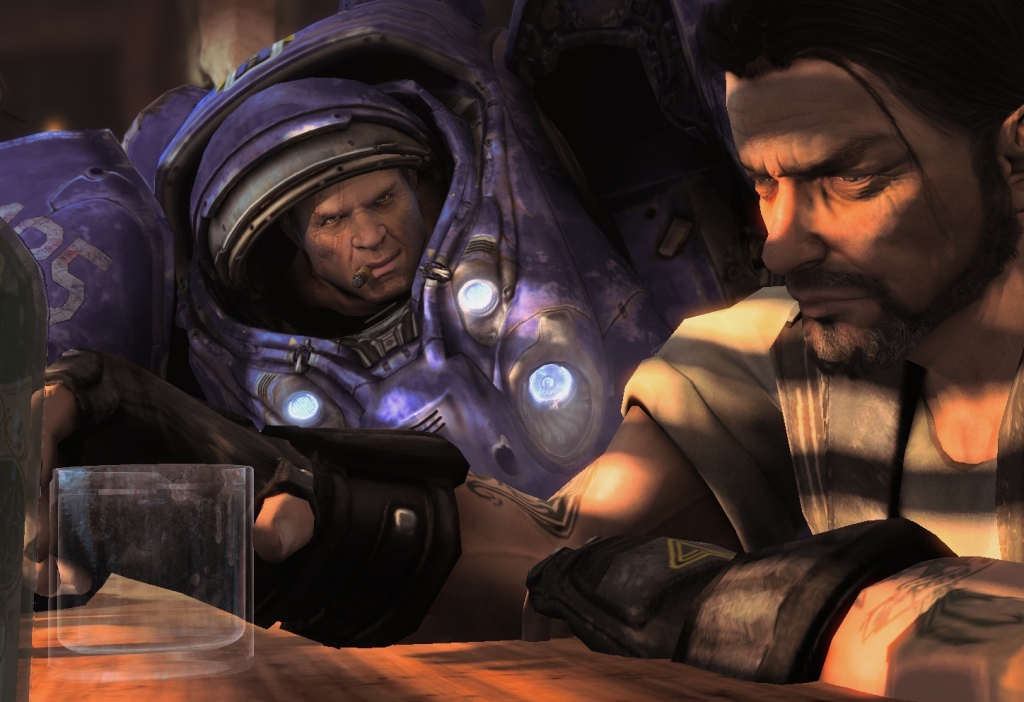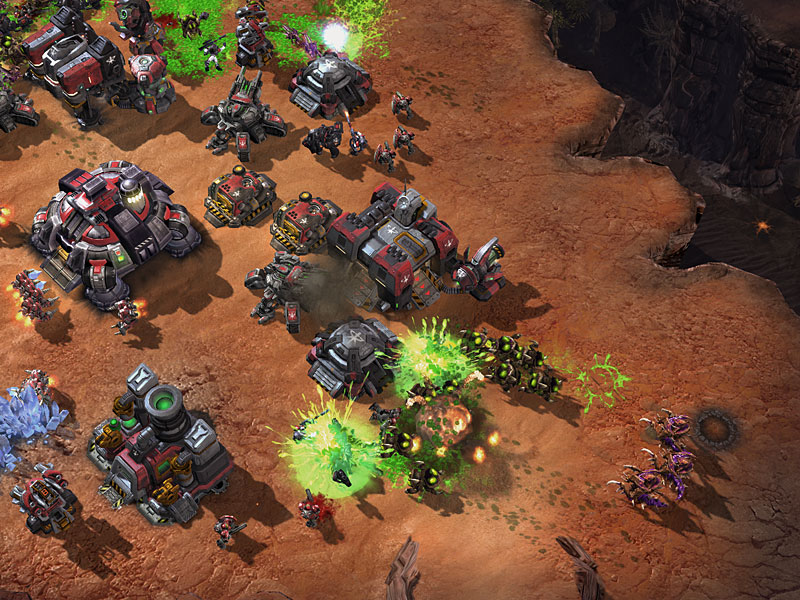Well folks, I finally beat the campaign in Starcraft 2 last night, so I finally feel comfortable reviewing the game.
In a lot of ways, Starcraft 2 is very similar to its predecessor, and I think on the whole that’s a good thing. With the original Starcraft, Blizzard hit on a formula for a compelling game that just worked, so they didn’t need to fix it. With Starcraft 2, they tweaked it instead. There are a lot of familiar units in the new version of the game, but there are also a lot of new ones, as well as new abilities for familiar units that make things interesting. There are also a lot of tiny, careful changes to the gameplay that make everything flow more smoothly.

Tychus Findlay and Jim Raynor at the bar.
For me, the campaign was always the highlight of the original Starcraft and I’m happy to report that it is excellent in Starcraft 2 as well. The story focuses on Jim Raynor who has had a make-over and is now a rugged, scarred mercenary. Instead of a linear storyline with little player choice like in the original game, Starcraft 2’s missions allow a little more flexibility: at any given time there are several missions to choose from. Between missions, you can interact with other characters on your ship. Head to the cantina and share a drink with Tychus Findlay, a rough-and-tumble ex-convict marine. Or go to the lab and see what new technologies Egon Stetman, the stereotypical squeaky-voiced, lab-coat-wearing, socially-awkward scientist has cooked up for you. Or check out the armory and ask Rory Swann – the mechanic who sounds like he belongs on Car Talk and looks like a Warcraft dwarf – to upgrade your mechanical units. Other colorful plot-related characters include the awesomely stereotyped Tosh – a rastafarian rogue ghost operative, complete with voodoo charms and a “ya mon” accent – and the idealistic young ship’s captain Matt Horner, whose clean-cut look and fancy uniform were carefully designed to contrast with Raynor’s bad-boy tattooed arms and sweat-stained t-shirt.

Tosh, the suspicious Jamaican operative. Yes, that is a voodoo doll around his neck.
This interesting bunch of characters send you on missions following several parallel plotlines that gradually intertwine to lead to the requisite huge battle at the end of the campaign. Each thread of missions is based on that character’s personal interests, and things get interesting when some of the characters disagree on what’s the best next step. All of these interactions are done really well using rendered-on-the-fly cutscenes. Some of these cutscenes are cinematics in their own right (at one point there’s a bar fight which was very well done) but there are also a few of Blizzard’s trademark spectacular pre-rendered cinematics for key plot points.
I really enjoyed the interplay between the missions and the “down time” on the ship: each mission gives you a new type of unit, some “research points” and some cash. The new unit is then available in all future missions and the research points and cash can be used to upgrade your units and hire mercenaries to help you. This adds another layer of customization to the game that worked really well.

Jim Raynor, Matt Horner and Tychus Findlay on the bridge of the Hyperion.
I also loved the variety of the actual campaign missions themselves. There are actually very few missions where you just build an army and destroy the enemy. There’s always something more going on. In one level, lava floods the low ground every few minutes. In another level, hordes of zombies attack you at night, and you have to hold the line until daybreak, when you can take the fight to them. The “hero” levels, where you just get a handful of special units to achieve your obectives, are really excellent too.
The story itself, like the story for the original Starcraft, is passable but not great. The problem with video game stories in general is that they exist primarily to get you to the next mission, so they are often not as developed as one might hope. Compared to most video games, Starcraft 2 has a very good story. Compared to most novels, it’s pretty weak. The writing is mediocre at times as well, with plenty of cliched lines and heavy-handed character development. But it gets the job done, and the fact that there are actual characters, and that they do develop a bit, is actually a great thing to see in a game!

The cantina. You can play some sweet tunes on the jukebox, or watch the latest amusing news broadcast from the Starcraft analog of Fox News.
A final aspect that I want to mention is the overall “feel” of the campaign. There was a certain Firefly-like “space western” vibe going on that I really enjoyed. This shows in everything from the (very good) in-game music, to the characters of Jim Raynor and Tychus Findlay (roughly analogous to Malcom Reynolds and Jayne Cobb in Firefly) to the jukebox on the ship that plays down-home favorites like “Sweet Home Alabama” and “A Zerg, A Shotgun and You“.
Bottom line, Starcraft 2 is a great game. The loving attention to detail that went into every aspect of the game is obvious. The campaign is full of really well-designed missions that lead you through several strands of an intertwining story to an exciting conclusion. The ability to customize your units between missions adds a nice dimension to the gameplay, as does the ability to interact with the various colorful (if blatantly stereotyped) characters on the ship.
And of course, once you’re done with the campaign, there are limitless hours of multiplayer fun to be had. You can work your way up the competitive ladder, or take advantage of the extremely powerful map editor that comes with the game and play custom maps made by other players, some of which are good enough to be separate games in their own right.
If that’s not enough, there are two expansions in the works. The campaign in Starcraft 2: Wings of Liberty is strictly Terran (with a few protoss missions thrown in). Each of the two expansions will focus on one of the other races in the Starcraft universe. I don’t think there are release dates set for the expansions yet, but it’s pretty clear that Starcraft 2 and its expansions will be keeping us busy for a long, long time.

Some of the pre-mission loading screens are pretty awesome too.













